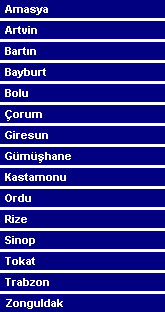| Giresun... |
|
In the 2nd century BC, the Roman general Lucullus, who came to the ancient Cerasos, saw a delicious fruit here,
and carried its trees back to his country. It was there then that the cherry (Kerasus) giving Giresun its name, spread all
over the world. 52 km east of Ordu, is this city founded near the ruins of a Byzantine fortress. Situated on a cliff
overlooking the sea, this old castle possesses a panoramic view. Inside the city, there exists a church dating to the
18th century. Just outside the harbor, is Giresun Island which also carries remains from the earliest times.
The ruins of a temple, built by the Amazons to whom the island is said to have belonged, can be seen here in addition to
a Byzantine Monastery. Travelling along the road to Trabzon, the towns of Kesap, Espiye, Tirebolu, Akcaabat, Gorele and
Dereli stand, each having a charming atmosphere with their natural and historical beauties. A special event is the
"Aksu Art and Culture Festival" for the interested ones, which is a yearly organization held every May. Plateaus
have a special role in the tourist activities of the city, as they are suitable for camping, picnicking and mountaineering.
are the most famous pletaus of are also suitable for winter sports Kumbet, Kulakkaya, Sisdagi, Karaovacik, Bektas and
Egribel. After the Romans conquered the Kingdom of Pontus, they discovered that the locals had orchards full of trees
bearing delicious little red fruits. One theory holds that the ancient name for the town, Cerasus, is the root for many
of the names for the fruit - cherry, cerise (French), kiraz (Turkish) - as well as for the town's modern name. Cherries
are still important here 20 centuries later. You can see the ruins of a mediaeval castle ("Giresun Kalesi") above the town.
In the eastern part of the city, a disused Greek Orthodox church has been turned into the City Museum. The ruins of a
Byzantine fortress offer a wonderful panorama of Giresun. It was from this city, ancient Cerasos, that the Roman general
Lucullus exported the first cherry trees to Europe. An 18th century church (now a museum) makes a short visit
worthwhile. Outside of town, Giresun Adasi (Giresun Island) is said to have once belonged to the Amazons. A ruined temple
supports this theory. The Aksu Art and Culture Festival is a yearly event in May. To get off the beaten track, take an
excursion to the high mountain yaylas of Bektas or Kümbet. Between Giresun and Trabzon, are the quaint coastal towns of
Kesap, Tirebolti, Görele, Vakfikebir and Akcaabat squeezed between wooded mountains and the Black Sea waters.
|
|

|


 454...
454...
 28...
28...
 524,010...
524,010...
 6,934...
6,934...
 38 E 24 - 40 N 55...
38 E 24 - 40 N 55...





